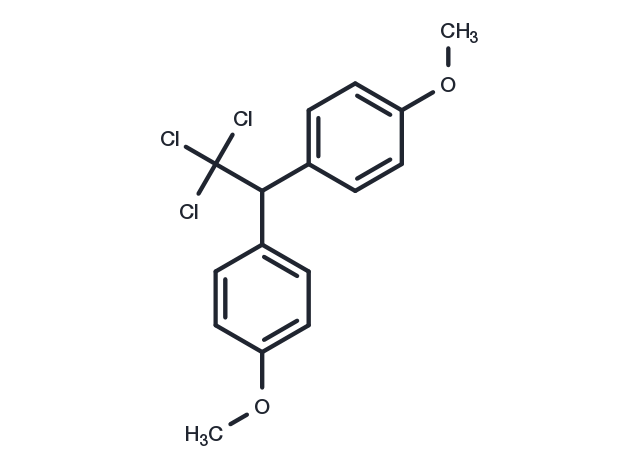Powder: -20°C for 3 years | In solvent: -80°C for 1 year


Methoxychlor, an organochlorine pesticide, is thought to be an endocrine disrupter that affects Ca2 homeostasis and cell viability in different cell models.

| Pack Size | Availability | Price/USD | Quantity |
|---|---|---|---|
| 5 mg | In stock | $ 37.00 | |
| 10 mg | In stock | $ 50.00 | |
| 25 mg | In stock | $ 68.00 | |
| 50 mg | In stock | $ 116.00 | |
| 100 mg | In stock | $ 173.00 | |
| 200 mg | In stock | $ 261.00 | |
| 500 mg | In stock | $ 497.00 | |
| 1 mL * 10 mM (in DMSO) | In stock | $ 51.00 |




| Description | Methoxychlor, an organochlorine pesticide, is thought to be an endocrine disrupter that affects Ca2 homeostasis and cell viability in different cell models. |
| In vitro | In HA59T cells, methoxychlor induced a [Ca2?]i rise by inducing Ca2? entry via protein kinase C-sensitive Ca2?-permeable channels, without causing Ca2? release from stores. Methoxychlor also induced apoptosis that was independent of [Ca2?]i rises. |
| Cell Research | Fura-2, a Ca2?-sensitive fluorescent dye, was applied to measure [Ca2?]i. Methoxychlor at concentrations of 0.1-1 μM caused a [Ca2?]i rise in a concentration-dependent manner. Removal of external Ca2? abolished methoxychlor's effect. Methoxychlor-induced Ca2? influx was confirmed by Mn2?-induced quench of fura-2 fluorescence. Methoxychlor-induced Ca2? entry was inhibited by nifedipine, econazole, SK&F96365, and protein kinase C modulators. Methoxychlor killed cells at concentrations of 10-130 μM in a concentration-dependent fashion. Chelation of cytosolic Ca2? with 1,2-bis(2-aminophenoxy) ethane-N,N,N',N'-tetraacetic acid/AM (BAPTA/AM) did not prevent methoxychlor's cytotoxicity. Methoxychlor (10 and 50 μM) induced apoptosis concentration-dependently as determined by using Annexin V/propidium iodide staining |
| Molecular Weight | 345.65 |
| Formula | C16H15Cl3O2 |
| CAS No. | 72-43-5 |
Powder: -20°C for 3 years | In solvent: -80°C for 1 year
DMSO: 22.5 mg/mL (65.1 mM)
You can also refer to dose conversion for different animals. More
bottom
Please see Inhibitor Handling Instructions for more frequently ask questions. Topics include: how to prepare stock solutions, how to store products, and cautions on cell-based assays & animal experiments, etc.
Methoxychlor 72-43-5 Others inhibitor inhibit
